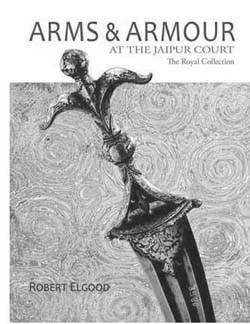Robert Elgood presents high-quality photographs of some two hundred items from the armoury of the Jaipur Court accompanied by technical descriptions and comments on the provenance of each. Sample, ‘hilt with the baluster grip with off-centre knop and projecting pommel’; or ‘nephrite “jade vert bronze” hilt … decorated with volutes, with two buds serving as vestigial quillons’. The author’s comments provide not only deeply-researched historical information but absorbing trivia for the curious browser.
‘To instruct and amuse the common people’ was the stated purpose of the Jaipur Museum, the foundation stone for which was laid in 1875–76 during the rule of Maharaja Ram Singh. The Economic and Industrial Museum—its full appellation—followed Victorian notions of what constituted art. The emphasis was on displaying an ‘industrial assemblage’, the best examples of manufacture from centres across India, not so much on exhibiting antiquities. Some 7,000 objects were shown at a ‘great exhibition’ in 1883 that had more than two lakh visitors in two months. The success of the exhibition led to the expansion of the museum to become, in the eyes of Rudyard Kipling who visited it in 1887, superior to any other in India. It is known today as the Central Museum. Given the importance of arms and armour in the lives of Rajputs, the best decorative work in metal was applied to their ornamentation making them a major feature of the museum. In 1957 Maharaja Sawai Madho Singh II opened a new museum in the City Palace complex to which he gifted a large number of arms from his personal collection. In this volume, Robert Elgood catalogues a sample of outstanding weapons and accoutrements from both museums.
The Kachhwaha Rajputs had a (usually) mutually-beneficial relationship with the Mughals. Akbar’s son by a Kachhwaha princess was the future emperor Jahangir who, too, married a Rajput to father Shahjahan. Rajput armies fought alongside the Mughals, imbibing their practices in warfare as well as the arts. Local painters and craftsmen combined the sophistication acquired at the Mughal court with their Hindu identity. Elgood observes that Rajput art ‘follows two distinct traditions that influence each other, a court art that draws on the art of the Mughals but is expressed increasingly in Hindu terms; and an exuberant, vibrant popular tradition’. European weaponry and techniques such as damascening too influenced local arms and armour. Some of the ‘first firangis’ in India, whose tales are engagingly told in an eponymous book by Jonathan Gil Harris, were European craftsmen and artisans in the Mughal court. Harris tells of William Leeds and John Story, respectively jeweller and painter, arriving in Agra in 1584 and inveigling their way into the royal ‘karkhana’; and of Augustin Hiriart whom Emperor Jahangir described as without peer as goldsmith and jeweller and accomplished in other skills including weaponry. Maharajas and nobility of Rajputana took delight in commissioning highlyembellished arms and armour, sometimes bordering on the eccentric. Decorative effects reflected status: the higher up the social scale the owner of the weapon, the more ornate and less functional it was likely to be.
The exhibits in Arms and Armour date between the sixteenth and nineteenth centuries. Elgood describes challenges in attribution and dating, despite possibilities for cross-verification offered by documents such as the Shah Jahan and Salim Albums, the Akbarnama, Hamzanama and others. Through scrutiny of these manuscripts, Mughal and Rajput paintings, and catalogues of modern museums, he teases out stories about the selected items. Publications on the crafts of Jaipur by Colonel Thomas Hendley, a British surgeon in Jaipur in the latter half of the nineteenth century, in particular, were helpful. Hendley was closely associated with the Jaipur museum which, he claimed, played an important role in influencing local craftsmen.

